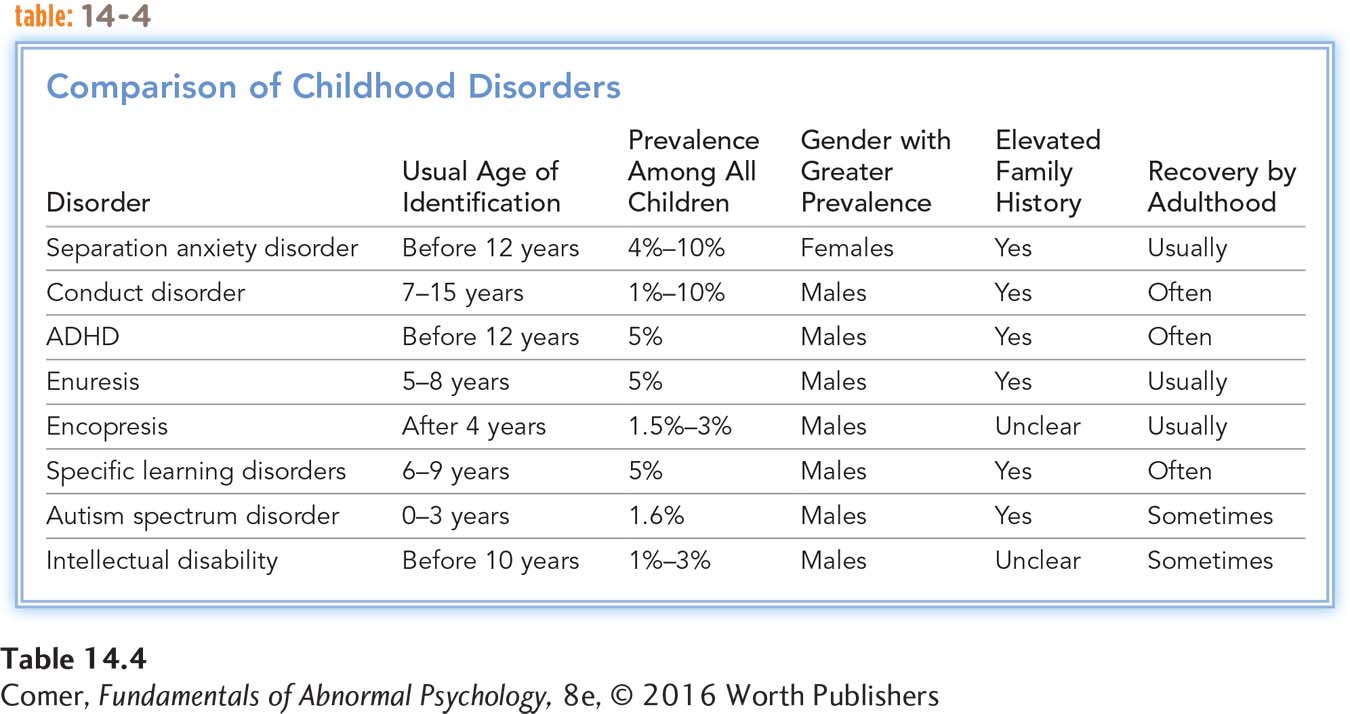14.5 Elimination Disorders
Children with elimination disorders repeatedly urinate or pass feces in their clothes, in bed, or on the floor. They already have reached an age at which they are expected to control these bodily functions, and their symptoms are not caused by physical illness.
Enuresis

enuresis A childhood disorder marked by repeated bed-
Enuresis is repeated involuntary (or in some cases intentional) bed-
The prevalence of enuresis decreases with age. As many as 33 percent of 5-
Research has not favored one explanation for enuresis over the others (Kim et al., 2014; Friman, 2008). Psychodynamic theorists explain it as a symptom of broader anxiety and underlying conflicts. Family theorists point to disturbed family interactions. Behaviorists view the problem as the result of improper, unrealistic, or coercive toilet training. And biological theorists suspect that children with this disorder often have a small bladder capacity or weak bladder muscles.
Most cases of enuresis correct themselves even without treatment. However, therapy, particularly behavioral therapy, can speed up the process (Axelrod et al., 2014; Christophersen & Friman, 2010). In a widely used classical conditioning approach, the bell-
Another effective behavioral treatment method is dry-
Encopresis
encopresis A childhood disorder characterized by repeated defecating in inappropriate places, such as one’s clothing.
Encopresis, repeatedly defecating into one’s clothing, is less common than enuresis, and it is also less well researched (Mash & Wolfe, 2015; APA, 2013). This problem seldom occurs at night during sleep. It is usually involuntary, starts at the age of 4 or older, and affects about 1.5 to 3 percent of all children (see Table 14.4). The disorder is much more common in boys than in girls.

Encopresis causes intense social problems, shame, and embarrassment (NLM, 2015; Mosca & Schatz, 2013). Children who suffer from it usually try to hide their condition and to avoid situations, such as camp or school, in which they might embarrass themselves. It may stem from stress, biological factors such as constipation, improper toilet training, or a combination of these factors. Because physical problems are so often linked to this disorder, a medical examination is typically conducted first.
The most common and successful treatments for encopresis are behavioral and medical approaches or a combination of the two (NLM, 2015; Collins et al., 2012; Christophersen & Friman, 2010). Treatment may include biofeedback training (see pages 118–


PsychWatch
Child Abuse
Aproblem that affects all too many children and has an enormous impact on their psychological development is child abuse, the nonaccidental use of excessive physical or psychological force by an adult on a child, often with the intention of hurting or destroying the child. At least 5 percent of children in the United States are physically abused each year (Mash & Wolfe, 2015). Surveys suggest that 1 of every 10 children is the victim of severe violence, such as being kicked, bitten, hit, beaten, or threatened with a knife or a gun. In fact, some researchers believe that physical abuse and neglect are the leading causes of death among young children.
Overall, girls and boys are physically abused at approximately the same rate. Although such abuse occurs in all socioeconomic groups, it is apparently more common among the poor (Romero-
Abusers are usually the child’s parents (Ben-
Studies suggest that the victims of child abuse may suffer immediate psychological effects such as anxiety, depression, bed-

Two forms of child abuse have received special attention: psychological and sexual abuse. Psychological abuse may include severe rejection, excessive discipline, scapegoating and ridicule, isolation, and refusal to provide help for a child with psychological problems. It probably accompanies all forms of physical abuse and neglect and often occurs by itself. Child sexual abuse, the use of a child for gratification of adult sexual desires, may occur outside or within the home (Murray, Nguyen, & Cohen, 2014; Faust et al., 2008). Surveys suggest that at least 13 percent of women and 4 percent of men are forced into sexual contact with an adult during childhood, many of them with a parent or step-
A variety of therapies have been used in cases of child abuse, including groups sponsored by Parents Anonymous, which help parents to develop insight into their behavior, provide training on alternatives to abuse, and teach coping and parenting skills (PA, 2014; Miller et al., 2007; Tolan et al., 2006). In addition, prevention programs, often in the form of home visitations and parent training, have proved promising (Beasley et al., 2014; Rubin et al., 2014).
Research suggests that the psychological needs of children who have been abused should be addressed as early as possible (Murray et al., 2014; Roesler & McKenzie, 1994). Clinicians and educators have launched valuable early detection programs that (1) educate all children about child abuse, (2) teach them skills for avoiding or escaping from abusive situations, (3) encourage children to tell another adult if they are abused, and (4) assure them that abuse is never their own fault (Miller et al., 2007; Finkelhor et al., 1995).
BETWEEN THE LINES
In Their Words
“Children nowadays are tyrants. They contradict their parents, gobble their food, and tyrannize their teachers.”
Socrates, 425 B.C.
Summing Up
CONDUCT DISORDER AND ELIMINATION DISORDERS Children with oppositional defiant disorder and conduct disorder exceed the normal breaking of rules and act very aggressively. Those with oppositional defiant disorder argue repeatedly with adults, ignore adult rules and requests, and feel intense anger and resentment. Those with conduct disorder, a more severe pattern, repeatedly violate the basic rights of others. Children with this disorder often are violent and cruel and may deliberately destroy property, steal, and run away. Clinicians have treated children with conduct disorders by using approaches such as parent–
Children with an elimination disorder—